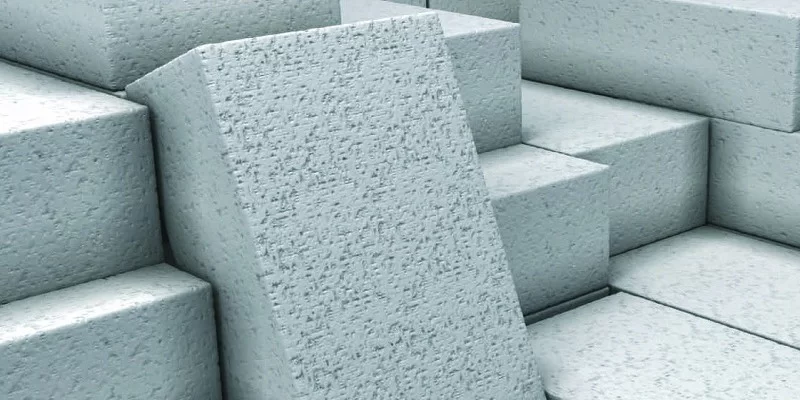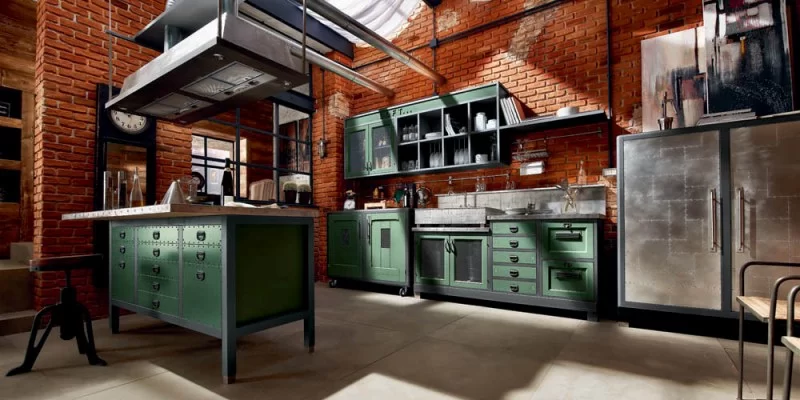
Compare brick and aerated concrete
Brick and aerated concrete blocks are two types of popular small-piece materials that are used in the construction of load-bearing, self-supporting walls and partitions of buildings. Our construction experts examined the properties and features of these materials, made a comparative analysis of their advantages and disadvantages, so that you can make an informed choice of one or another material.
Brick

Brick can be divided into two main types — ceramic and silicate.
Ceramic brick and stone
Ceramic bricks are made by molding products from a plastic clay mass, which are then fired in kilns, which gives them the strength of stone. Brick can be ordinary and effective. An ordinary brick is full-bodied, but in an efficient one, round or rectangular voids are formed during the production process. The use of effective products makes it possible to improve the heat-shielding qualities of the walls being built, while reducing their thickness in comparison with walls made of solid bricks.
In addition to ceramic bricks, ceramic stone is also used in construction today. The difference between the stone is its large size and the obligatory presence of voids. Internal and external walls, partitions, columns, as well as foundations are built from ceramic stone and brick. The standard color of products is red, but with the help of coloring pigments, materials are given various shades of the standard color.
Since the outer walls of modern brick buildings are now made three-layered — with an inner layer that performs a load-bearing function, a layer of insulation and an outer, facing layer — a special facing or facing brick and stone is produced for cladding. The side of the facing products, which will be outside the facade of the building, is treated in various ways to give decorative properties. In addition to rectangular facing bricks, some manufacturers produce many types of figured products to create facades with complex architectural elements.
Technical characteristics of ceramic products:
-
in size, a brick can be of three types — ordinary 250x120x65 mm, thickened 250x120x80 mm and modular 288x138x63mm;
-
stone — ordinary 250x120x138 mm, enlarged 250x250x138 mm, modular 288x138x138 mm. In addition, there is a stone with horizontal voids, the dimensions of which are 250x150x120 (250) mm;
-
facing brick — ordinary 250x120x65 mm, thickened 250x120x88 mm, modular 288x138x63 mm;
-
facing stone — ordinary 250x120x138 mm, enlarged 250x250x138 mm, modular 288x138x138 mm.
-
strength grade, that is, the ability of the product to withstand a vertical compressive load — for ordinary products M75-M300, for front products M75-M150;
-
brand for frost resistance, that is, the ability to withstand a certain number of cycles of alternate freezing-thawing: F 15.25.35.75;
-
average density: for effective brick and stone — 1400-1450 kg / m3, for ordinary — 1600 kg / m3;
-
water absorption of facial products — no more than 14%.
silicate brick
They are made from a raw mass, which includes sand, lime, water, pigments, by pressing in molds and subsequent treatment with hot steam in an autoclave. According to the varieties of form, it is similar to ceramic, it is divided into ordinary and facial, it can be full-bodied and hollow. The standard color of silicate products is white, but face bricks are usually painted in different colors with the addition of pigments.
Specifications:
-
in size: single 250x120x65 mm, modular (necessarily hollow) 250x120x88 mm, modular stone 250x120x138 mm;
-
strength grade — M75 — M300;
-
frost resistance — F15, 25, 35, 50;
-
average density — 1800-1850 kg / m3;
-
water absorption — no more than 14% for facial products.
aerated concrete

Aerated concrete blocks are produced under industrial conditions from a mixture of cement, quartz sand, quicklime and water, to which a certain amount of aluminum powder is added. After adding this reagent to the solution, the mixture is immediately transferred to special containers, where, as a result of a chemical reaction, swelling and an increase in the volume of the raw mass occur due to the formation of hydrogen gas, which creates small pores evenly distributed throughout the product. After the concrete mass reaches a certain stage of intermediate hardening, it is cut on a special machine using wire strings into blocks of standard size. The final stage in the manufacture of aerated concrete blocks is autoclaving with high-pressure steam, where the products gain the established strength. Finished products are then processed on milling equipment — if necessary, grooves and ridges are cut at the ends, and the surfaces are finished.
It should be noted that prefabricated autoclaved aerated concrete blocks are often confused with foam concrete blocks. Foam concrete blocks can be produced both in the conditions of the production workshop and directly on the construction site. The initial raw mix for the production of foam concrete blocks consists of cement, sand, water and foam, prepared separately using a special foaming agent. The mixture is placed in special forms, where during hardening the foam bubbles are distributed evenly throughout the volume of the solution, resulting in foam concrete. At the same time, the process of gaining the necessary strength proceeds at natural temperature and humidity.
Aerated concrete blocks are manufactured using high-tech equipment in the factory, which makes it possible to obtain products of higher quality than foam concrete ones. For example, the deviation from standard geometric dimensions for aerated concrete blocks should be 1–3 mm, while for foam concrete blocks this value can be an order of magnitude higher. Characteristics such as the coefficient of thermal conductivity, strength at a certain density for aerated concrete blocks are also better than for foam concrete blocks.
Aerated concrete blocks are divided into wall partitions in size and into heat-insulating, heat-insulating-structural and structural in terms of density and strength. In addition, other types of blocks are produced: with handles for gripping, tongue-and-groove ends for creating tight locks during masonry, U-shaped — for arranging reinforced lintels in masonry.
Specifications
Aerated concrete blocks are manufactured in accordance with GOST 31360-2007, according to which products must comply with the following parameters and technical characteristics:
-
thickness of wall blocks — from 200 to 500 mm, thickness of partition walls — 100-150 mm, length — 600 and 625 mm, height 200, 250, 300 mm;
-
heat-insulating blocks of grades D300-D500 have a density of 300-500 kg/m3;
-
strength class: D300 — B1 (10-15 kg/cm2), D400 — B2.5 (32 kg/cm2), D500 — B3.5 (46 kg/cm2), D600 — B4 (55 kg/cm2), D700 — B5 (65 kg/cm2), D800 — B7.5 (98 kg/cm2), D900 — B10 (130 kg/cm2), D1000 — B12.5 (164 kg/cm2), D1100 — B15 (196 kg /cm2), D1200 — B20 (262 kg/cm2;
-
Frost resistance — F25-F50;
-
Water absorption — more than 50%.
Table of advantages and disadvantages
|
|
|
|
|
|
+ high strength. That allows you to build any load-bearing structures, up to foundations;
+ durability — brick houses can serve up to 100 years or more;
+ environmental friendliness — made exclusively from natural materials;
+ fire safety — the material is non-combustible;
+ aesthetic appearance, the choice of shades of color, allowing you to create facades that are complex from an architectural point of view;
+ high soundproof qualities;
+ low water absorption characteristics, which gives special resistance to atmospheric influences.
|
— high cost, almost twice as much as that of a brick;
— large weight, which requires the construction of a powerful and expensive foundation;
— laboriousness and complexity of masonry from small elements, requiring highly qualified performers;
— the possibility of efflorescence on the facing masonry, which has to be removed in various laborious ways;
— heat-shielding properties are worse than those of aerated concrete blocks.
|
|
|
+ due to the large size, the construction time is reduced, since the laying is carried out faster;
+ the blocks are laid on the adhesive composition, which helps to increase the heat-shielding properties of the walls by reducing the thickness of the seam, that is, the exclusion of cold bridges;
+ environmental friendliness — products are made from pure natural materials;
+ easy to process with a hand tool — sawn, cut. In this regard, when laying utilities in the walls, strobes and holes break through without problems;
+ fire safety — blocks belong to the category of non-combustible materials;
+ high soundproof qualities;
+ high thermal insulation properties, higher than that of a brick;
+ light weight allows you to do without the construction of heavy foundations, which reduces the cost of construction;
+ good vapor permeability, allowing the walls to «breathe», providing a healthy microclimate in the premises.
|
— increased hygroscopicity, that is, the ability to absorb moisture, so the outer walls must be protected from moisture with the help of special impregnations;
— fragility — under mechanical action, the blocks break easily;
— require external cladding;
— Tendency to shrinkage, which requires masonry reinforcement.
|
The main differences between materials
The main differences between the materials are as follows:
-
are made from different raw materials;
-
differ in size;
-
masonry is made using different compositions — brick using a cement-sand mortar, from blocks — using an adhesive composition;
-
brick is much heavier than blocks;
-
brick is much stronger;
-
blocks are much more hygroscopic than bricks;
-
brick has a more aesthetic appearance, suitable for architectural design of facades;
-
brick is much more expensive than aerated concrete blocks.
What is the similarity of materials
The similarity of materials is as follows:
both materials are small pieces, with which you can lay the walls;
brick and blocks are suitable for the construction of the same structures;
both materials are environmentally friendly;
both materials are fireproof;
and brick and blocks provide good sound insulation.
Conclusions: An unambiguous conclusion about what is better — brick or aerated concrete blocks cannot be made. Both materials have their advantages and disadvantages and, accordingly, the right to use. If financial possibilities allow, then, of course, it is better to build a house entirely of bricks. In the budget case, it is quite possible to use aerated concrete blocks. A good option is when both materials are used, for example, blocks are used for laying internal walls, and the lining is made of bricks.

Добавить комментарий
Для отправки комментария вам необходимо авторизоваться.